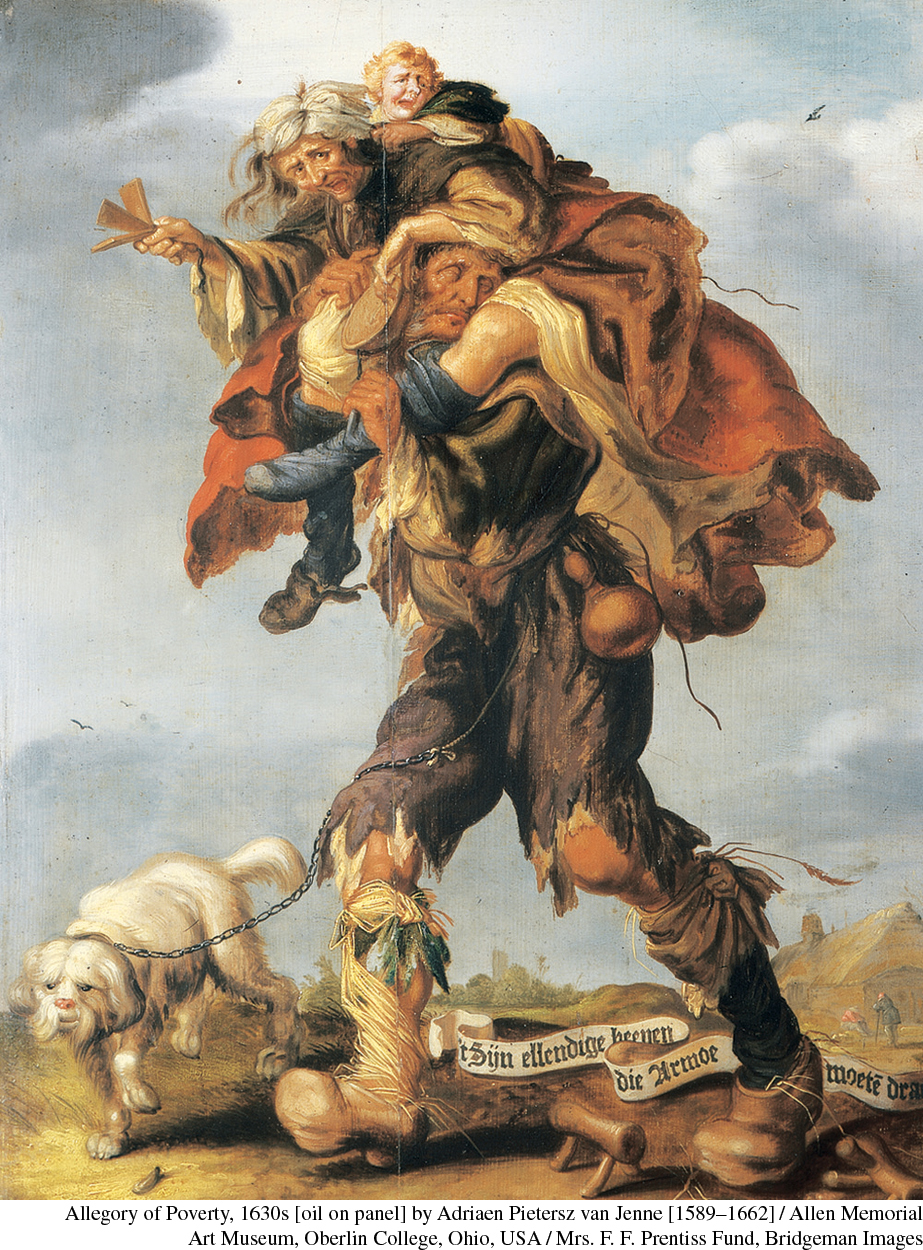Consequences for Daily Life
Consequences for Daily Life

The recession of the early 1600s had both short-term and long-term effects. In the short term, it aggravated the threat of food shortages, increased the outbreaks of famine and disease, and caused people to leave their families and homes. In the long term, it deepened the division between prosperous and poor peasants and fostered the development of a new pattern of late marriages and smaller families.
When grain harvests fell short, peasants immediately suffered because, outside of England and the Dutch Republic, grain had replaced more expensive meat as the essential staple of most Europeans’ diets. By the end of the sixteenth century, the average adult European ate more than four hundred pounds of grain per year. Peasants lived on bread, soup with a little fat or oil, peas or lentils, garden vegetables in season, and only occasionally a piece of meat or fish.
When faced with famine, most people simply left their huts and hovels and took to the road in search of food and charity. Men left their families to search for better conditions elsewhere. Those left behind might be reduced to eating chestnuts, roots, bark, and grass. In eastern France in 1637, a witness reported, “The roads were paved with people. . . . Finally it came to cannibalism.” Compassion sometimes gave way to fear when hungry vagabonds became more aggressive, occasionally threatening to burn a barn if they were not given food.
Successive bad harvests led to malnutrition, which weakened people and made them more susceptible to such epidemic diseases as the plague, typhoid fever, typhus, dysentery, smallpox, and influenza. The plague was feared most: in one year it could cause the death of up to half of a town’s or village’s population, and it struck with no discernible pattern. Nearly 5 percent of France’s entire population died just in the plague of 1628–1632.
Economic crisis widened the gap between rich and poor. Peasants paid rent to their landlords as well as fees for inheriting or selling land and tolls for using mills, wine presses, or ovens. States collected direct taxes on land and sales taxes on consumer goods such as salt, an essential preservative. Protestant and Catholic churches alike exacted a tithe (a tax equivalent to one-tenth of the parishioner’s annual income); often the clergy took their tithe in the form of crops and collected it directly during the harvest. Any reversal of fortune could force peasants into the homeless world of vagrants and beggars, who numbered as much as 2 percent of the total population.
In England, the Dutch Republic, northern France, and northwestern Germany, improvements gave some peasants the means to become farmers who rented substantial holdings, produced for the market, and in good times enjoyed relative comfort and higher status. Those who could not afford to plant new crops such as maize (American corn) or to use techniques that ensured higher yields became simple laborers with little or no land of their own. One-half to four-fifths of the peasants did not have enough land to support a family. They descended deeper into debt during difficult times and often lost their land to wealthier farmers or to city officials intent on developing rural estates.
As the recession deepened, women lost some of their economic opportunities. Widows who had been able to take over their late husbands’ trade now found themselves excluded by the urban guilds or limited to short tenures. Many women went into domestic service until they married, some for their entire lives. Town governments carefully regulated the work of female servants, requiring women to stay in their positions unless they could prove mistreatment by a master.
European families reacted to economic downturn by postponing marriage and having fewer children. When hard times passed, more people married and had more children. But even in the best of times, one-fifth to one-quarter of all children died in their first year, and half died before age twenty. Childbirth still carried great risks for women, about 10 percent of whom died in the process. Midwives delivered most babies; physicians were scarce, and even those who did attend births were generally less helpful than midwives. The Englishwoman Alice Thornton described in her diary how a doctor bled her to prevent a miscarriage after a fall (bloodletting, often by the application of leeches, was a common medical treatment); her son died anyway in a breech birth that almost killed her, too.
Beginning in the early seventeenth century and continuing until the end of the eighteenth, families in all ranks of society started to limit the number of children. Because methods of contraception were not widely known, they did this for the most part by marrying later; the average age at marriage during the seventeenth century rose from the early twenties to the late twenties. The average family had about four children. Poorer families seem to have had fewer children, wealthier ones more. Because Protestant and Catholic clergy alike stressed sexual fidelity and abstinence before marriage, the number of births out of wedlock was relatively small (2–5 percent of births); premarital intercourse was generally tolerated only after a couple had announced their engagement.